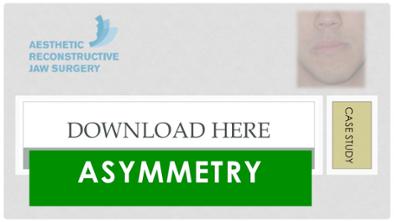Share this
Asymmetry of jaws - abnormal growth or disproportionate development
on September 19, 2015

Everybody has asymmetry to a certain extent. The left side is not a mirror image of the right and is never meant to be. Internally, our organs are even more different. As such nobody is symmetrical. However, gross facial asymmetry is also a sign that something is not quite right. While most cases of facial asymmetry are caused by disproportionate development between the left and right side, some cases are caused by disease. While developmental disharmonies poses primarily cosmetic problems, abnormal growth diseases such as fibrous dysplasia may result in functional problems as well.
Fibrous dysplasia is a disorder in bone formation caused by a gene mutation. It often presents at a young age and may be mistaken for developmental disharmony especially when it affect the lower jaw. I had a patient who was referred to me by her orthodontist for orthognathic surgery to correct her asymmetry of jaws. She has enlargement of the left side of her lower jaw that results in not just a deviation of the jaw to the right side but also a protruding jaw, something that was commonly referred to as an underbite, but only on the left side. At first glance, it did seem like the typical asymmetry of the jaws. However, x-rays showed the bone on the left side of the lower jaw had a different consistency and density compared with the right. It appeared lighter on x-rays and did not have the trabecular pattern of normal bone. A biopsy was done and a diagnosis of fibrous dysplasia was confirmed. With such a diagnosis, the treatment plan to address the deformity changed signficantly. As there was no functional problem caused by this disease, we decided not to do any treatment and monitor it for a while as the patient was only about 14 years old. fibrous dysplasia can continue to develop for some years and any treatment done then would probably need revision later. After a few years, the asymmetry got worse and the patient began to be affected by the aesthetic challenge, I did some debulking surgery for her to reduce the size of the lower jaw. Orthognathic surgery was not needed as she was satisfied with the improvement in facial aesthetics and she corrected her bite with orthodontics alone.
When fibrous dysplasia affects the upper jaw, the problems may be potentially more significant. If the dysplasia extend to the ear and eye, it can affect hearing and vision. Another young patient of mine who was referred by an ENT colleague has fibrous dysplasia in the upper jaw, extending to the cheek bone. For this case, options of early debulking surgery or monitoring were discussed with the parents and they opted for the latter.
 Orthognathic surgery can be performed on bones affected by fibrous dysplasia. Although the bone structure is different, it is still amenable to the surgery and healing is not affected. This, however, should be done at a much later stage than patients without fibrous dysplasia so as to give the disese more time to "burn out". Monitoring with radiographs and bone scans can give a idea of the status of the disease and whether to proceed with orthognathic surgery. Once it was deemed to be slowed or stopped, orthognathic surgery can be done as with other patients.
Orthognathic surgery can be performed on bones affected by fibrous dysplasia. Although the bone structure is different, it is still amenable to the surgery and healing is not affected. This, however, should be done at a much later stage than patients without fibrous dysplasia so as to give the disese more time to "burn out". Monitoring with radiographs and bone scans can give a idea of the status of the disease and whether to proceed with orthognathic surgery. Once it was deemed to be slowed or stopped, orthognathic surgery can be done as with other patients.
Share this
- Jaw Surgery (93)
- Dental Implants Singapore (90)
- Orthognathic Surgery (48)
- Replacing Missing Teeth (26)
- Missing Teeth Options (23)
- Underbite (23)
- Bone Grafting (21)
- Costs (18)
- Facial Aesthetics (18)
- Aesthetics (17)
- dental implants (16)
- corrective jaw surgery (15)
- BOTOX (11)
- Dermal Fillers (11)
- Wisdom teeth (10)
- Fixed Implant Dentures (8)
- Loose Dentures Singapore (6)
- Medisave (6)
- sleep apnea (6)
- Braces (5)
- Dental Pain (5)
- Dentures in Singapore (5)
- Loose Teeth (5)
- Tooth Extraction (5)
- jaw deformities (5)
- bimax (4)
- bone graft (4)
- maxillomandibular advancement (4)
- all-on-4 (3)
- bimaxillary protrusion (3)
- chin implant (3)
- facial asymmetry (3)
- full mouth dental implants (3)
- genioplasty (3)
- immediate implant (3)
- removal of an integrated dental implant (3)
- third molars (3)
- wisdom tooth surgery (3)
- My Dentures Don't Fit (2)
- VME (2)
- bone graft healing (2)
- distraction osteogenesis (2)
- medical tourism (2)
- obstructive sleep apnea (2)
- orthodontics (2)
- plastic surgery (2)
- CT guided dental implants (1)
- Double jaw surgery (1)
- Invisalign (1)
- Periodontal Disease (1)
- Permanent Dentures Singapore (1)
- before and after photos (1)
- facial trauma (1)
- fractured dental implant (1)
- oral appliance therapy (1)
- root canal treatment (1)
- veneers (1)
- vertical maxillary excess (1)
- September 2019 (2)
- July 2019 (2)
- May 2019 (2)
- August 2018 (1)
- October 2017 (1)
- September 2017 (2)
- August 2017 (1)
- June 2017 (2)
- May 2017 (4)
- April 2017 (1)
- March 2017 (1)
- February 2017 (3)
- January 2017 (3)
- December 2016 (1)
- November 2016 (2)
- October 2016 (4)
- September 2016 (9)
- August 2016 (5)
- July 2016 (11)
- June 2016 (14)
- May 2016 (6)
- April 2016 (2)
- March 2016 (1)
- January 2016 (7)
- December 2015 (10)
- November 2015 (4)
- October 2015 (9)
- September 2015 (7)
- August 2015 (1)
- July 2015 (6)
- June 2015 (3)
- May 2015 (7)
- April 2015 (5)
- March 2015 (8)
- January 2015 (5)
- December 2014 (7)
- November 2014 (7)
- October 2014 (6)
- September 2014 (8)
- August 2014 (5)
- July 2014 (7)
- June 2014 (8)
- May 2014 (9)
- April 2014 (10)
- March 2014 (6)
- February 2014 (8)
- January 2014 (3)
Subscribe by email
Email subscription




No Comments Yet
Let us know what you think